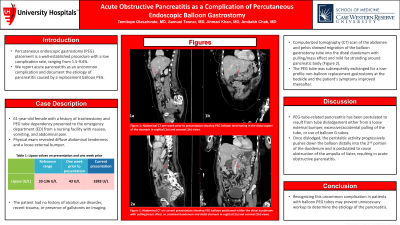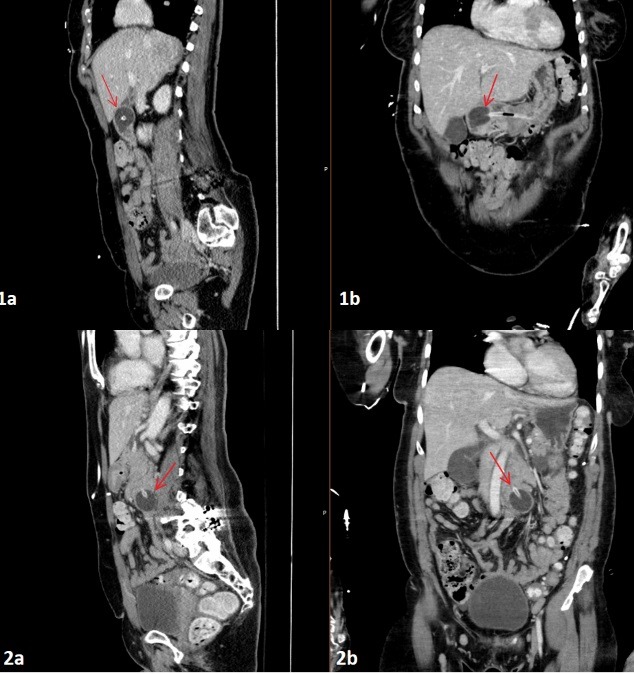Monday Poster Session
Category: Biliary/Pancreas
P1551 - Acute Obstructive Pancreatitis as a Complication of Percutaneous Endoscopic Balloon Gastrostomy
Monday, October 23, 2023
10:30 AM - 4:15 PM PT
Location: Exhibit Hall

Has Audio

Temitope Olasehinde, MD
Case Western Reserve University / University Hospitals
Cleveland, OH
Presenting Author(s)
Temitope Olasehinde, MD1, Samuel Tanner, MD1, Ahmad Khan, MD1, Amitabh Chak, MD2
1Case Western Reserve University / University Hospitals, Cleveland, OH; 2Digestive Health Institute, University Hospitals Cleveland Medical Center, Cleveland, OH
Introduction: Percutaneous endoscopic gastrostomy (PEG) placement is a well-established procedure with a low complication rate, ranging from 1.5-9.4%. We report acute pancreatitis as an uncommon complication and document the etiology of pancreatitis caused by a replacement balloon PEG.
Case Description/Methods: A 61-year-old female with a history of tracheostomy and PEG tube dependency presented to the emergency department (ED) from a nursing facility with nausea, vomiting, and abdominal pain. Physical exam revealed diffuse abdominal tenderness and a loose external bumper. Labs were significant for lipase of 3383 U/L (reference: 9-82 U/L) and alkaline phosphatase of 200 U//L (reference: 33-136 U/L). The patient had no history of alcohol use disorder, recent trauma, or presence of gallstones on imaging. Computerized tomography (CT) scan of the abdomen and pelvis showed a balloon gastrostomy tube where the balloon had migrated and was now positioned within the distal duodenum with pulling/mass effect on the proximal duodenum and distal stomach (Figure 1). Mild fat stranding was noted around the pancreatic body and tail suggestive of acute pancreatitis. The patient had abdominal imaging during the previous week where the PEG balloon was noted to be in the appropriate gastric location (Figure 1). The PEG tube was subsequently exchanged for a low-profile non-balloon replacement gastrostomy at the bedside and the patient's symptoms improved thereafter. The patient was discharged to her nursing facility the following day.
Discussion: With the increased placement frequency of PEG tubes in recent years, tube dislodgement has become increasingly common with an incidence ranging between 4–13%, particularly in balloon gastrostomy tubes. PEG-tube-related pancreatitis has been postulated to result from tube dislodgement either from a loose external bumper, excessive/accidental pulling of the tube, or use of balloon G-tubes. Once dislodged, the peristaltic activity progressively pushes down the balloon distally into the 2nd portion of the duodenum and is postulated to cause obstruction of the ampulla of Vater, resulting in acute obstructive pancreatitis. This case uniquely demonstrates this mechanism, with the PEG balloon correctly positioned one week prior on CT imaging, and then visualized to have subsequently migrated to the 2nd portion of the duodenum on presentation. Recognizing this uncommon complication in patients with balloon PEG tubes may prevent unnecessary workup to determine the etiology of the pancreatitis.

Disclosures:
Temitope Olasehinde, MD1, Samuel Tanner, MD1, Ahmad Khan, MD1, Amitabh Chak, MD2. P1551 - Acute Obstructive Pancreatitis as a Complication of Percutaneous Endoscopic Balloon Gastrostomy, ACG 2023 Annual Scientific Meeting Abstracts. Vancouver, BC, Canada: American College of Gastroenterology.
1Case Western Reserve University / University Hospitals, Cleveland, OH; 2Digestive Health Institute, University Hospitals Cleveland Medical Center, Cleveland, OH
Introduction: Percutaneous endoscopic gastrostomy (PEG) placement is a well-established procedure with a low complication rate, ranging from 1.5-9.4%. We report acute pancreatitis as an uncommon complication and document the etiology of pancreatitis caused by a replacement balloon PEG.
Case Description/Methods: A 61-year-old female with a history of tracheostomy and PEG tube dependency presented to the emergency department (ED) from a nursing facility with nausea, vomiting, and abdominal pain. Physical exam revealed diffuse abdominal tenderness and a loose external bumper. Labs were significant for lipase of 3383 U/L (reference: 9-82 U/L) and alkaline phosphatase of 200 U//L (reference: 33-136 U/L). The patient had no history of alcohol use disorder, recent trauma, or presence of gallstones on imaging. Computerized tomography (CT) scan of the abdomen and pelvis showed a balloon gastrostomy tube where the balloon had migrated and was now positioned within the distal duodenum with pulling/mass effect on the proximal duodenum and distal stomach (Figure 1). Mild fat stranding was noted around the pancreatic body and tail suggestive of acute pancreatitis. The patient had abdominal imaging during the previous week where the PEG balloon was noted to be in the appropriate gastric location (Figure 1). The PEG tube was subsequently exchanged for a low-profile non-balloon replacement gastrostomy at the bedside and the patient's symptoms improved thereafter. The patient was discharged to her nursing facility the following day.
Discussion: With the increased placement frequency of PEG tubes in recent years, tube dislodgement has become increasingly common with an incidence ranging between 4–13%, particularly in balloon gastrostomy tubes. PEG-tube-related pancreatitis has been postulated to result from tube dislodgement either from a loose external bumper, excessive/accidental pulling of the tube, or use of balloon G-tubes. Once dislodged, the peristaltic activity progressively pushes down the balloon distally into the 2nd portion of the duodenum and is postulated to cause obstruction of the ampulla of Vater, resulting in acute obstructive pancreatitis. This case uniquely demonstrates this mechanism, with the PEG balloon correctly positioned one week prior on CT imaging, and then visualized to have subsequently migrated to the 2nd portion of the duodenum on presentation. Recognizing this uncommon complication in patients with balloon PEG tubes may prevent unnecessary workup to determine the etiology of the pancreatitis.

Figure: Figure 1: Abdominal CT one week prior to presentation showing PEG balloon terminating in the distal aspect of the stomach in sagittal (1a) and coronal (1b) views. Abdominal CT on current presentation showing PEG balloon positioned within the distal duodenum with pulling/mass effect on proximal duodenum and distal stomach in sagittal (2a) and coronal (2b) views.
Disclosures:
Temitope Olasehinde indicated no relevant financial relationships.
Samuel Tanner indicated no relevant financial relationships.
Ahmad Khan indicated no relevant financial relationships.
Amitabh Chak indicated no relevant financial relationships.
Temitope Olasehinde, MD1, Samuel Tanner, MD1, Ahmad Khan, MD1, Amitabh Chak, MD2. P1551 - Acute Obstructive Pancreatitis as a Complication of Percutaneous Endoscopic Balloon Gastrostomy, ACG 2023 Annual Scientific Meeting Abstracts. Vancouver, BC, Canada: American College of Gastroenterology.

